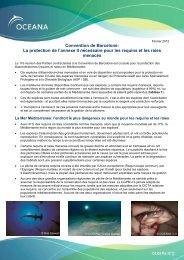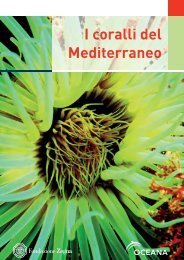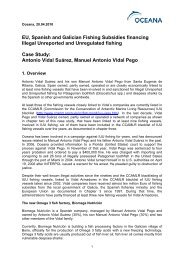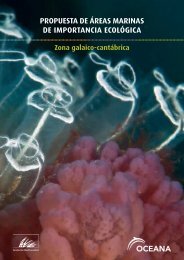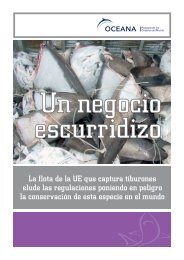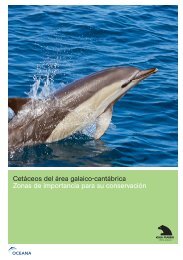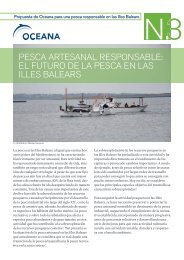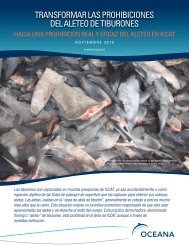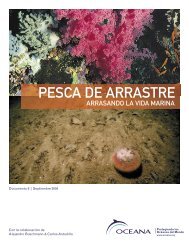Download - Oceana
Download - Oceana
Download - Oceana
You also want an ePaper? Increase the reach of your titles
YUMPU automatically turns print PDFs into web optimized ePapers that Google loves.
4. Gorgonian gardens<br />
4.1. Mixed gorgonian garden (Eunicella spp., Leptogorgia spp., Paramuricea clavata) on<br />
infralittoral and circalittoral rocky bottom<br />
There are 6 species of gorgonian documented by OCEANA as part of these mixed gardens: Eunicella<br />
labiata, E. gazella, E. verrucosa, Leptogorgia lusitanica, L. sarmentosa and Paramuricea clavata.<br />
Their presence depends on the localization and depth where the mixed gardens develop. Some species<br />
(Eunicella verrucosa and Leptogorgia spp.) have been documented both at the Cantabrian Sea (Bay of<br />
Biscay) and the Gulf of Cádiz, as well as in waters on the Southwest of Portugal; other species (Eunicella<br />
gazella, E. singularis, E. labiata and Paramuricea clavata) were only found in Cádiz and in Portuguese<br />
waters, and they are not present in the mixed gardens documented in the Cantabrian Sea.<br />
Regarding the depth, while some species show a very broad bathymetric range (Eunicella labiata, E.<br />
verrucosa), other species are more predominant in shallow waters (E. gazella, Leptogorgia spp.) and<br />
others appear more abundantly in deeper areas (Paramuricea clavata).<br />
Based on the predominance of the indicated species in the mixed gardens documented by OCEANA, we<br />
have classified these gardens in several categories:<br />
4.1. 1. Mixed gorgonian garden (Eunicella verrucosa, Leptogorgia lusitanica and L. sarmentosa) on<br />
infralittoral rocky bottom<br />
DESCRIPTION: These mixed gardens of gorgonians occur on abrupt rocky bottom, with vertical walls. In<br />
front of the Ballena de Sonabia (Cantabrian Sea, Bay of Biscay), at a depth of around 20 m, the<br />
predominant gorgonian species are Eunicella verrucosa, Leptogorgia lusitanica and L. sarmentosa: the<br />
last being the less abundant that the first two species.<br />
Rocks on which these gardens grow are covered by algae and a many organisms can be found on them,<br />
such as anthozoans, hydrozoans, echinoderms, porifera, molluscs, bryozoans, polychaetes, crustaceans,<br />
foraminifera and ascidians. Also a lot of fish species are part of this community.<br />
Sometimes, small gardens made up of only one of these species can be found. This is the case of the<br />
garden of Leptogorgia sarmentosa developed on the bottom of Os Meixidos bank (Galicia), at around 40<br />
metres depth, also on a rocky bottom with no sediment.<br />
DEPTH: 18 - 40 m<br />
TYPE OF SUBSTRATE: Rocky bottom, abrupt. This type of mixed gorgonian gardens frequent forms<br />
habitats on rocky overhangs and walls, on areas with no sediment.<br />
20



